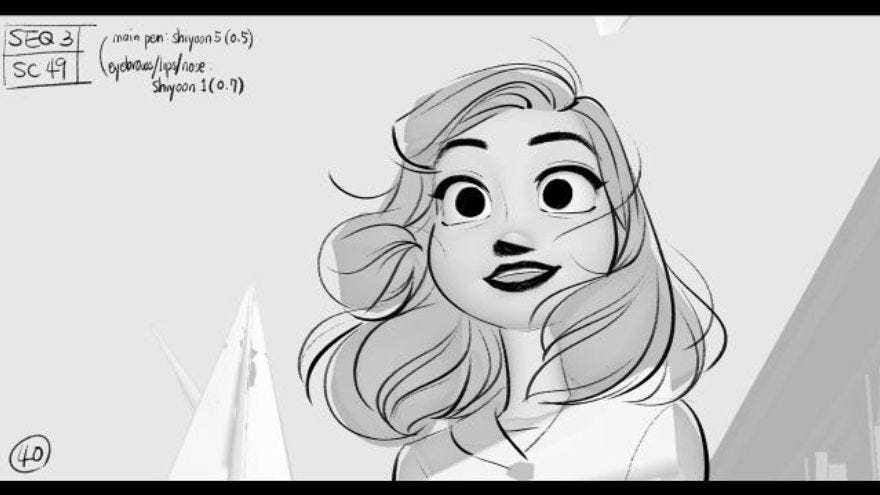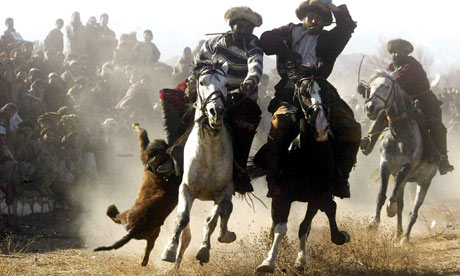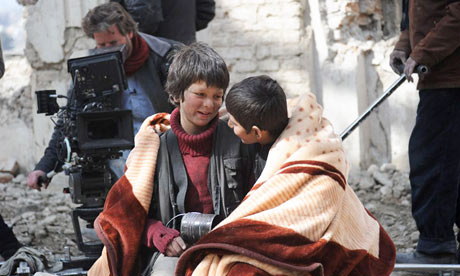I expected much more from Oliver Nakache and Eric Toledano's
The Intouchables (2011, but not released in the U.S. until 2012). Another film based on a true story, it broke box office records in France. The wealthy Philippe (François Cluzet) is a quadriplegic who requires full time care and has gone through a steady stream of caregivers of various stripes. When ghetto ruffian Driss (exuberantly played by the handsome Omar Sy) barges into an interview out of turn, Philippe senses the bravado might be a good sign and hires him. After a couple of false starts, an abiding friendship begins to emerge. Unfortunately, despite sensitive performances and gentle humor, it relies too heavily on stereotypes. (A. O. Scott's NYT
review)

American-born Israeli director Joseph Cedar's
Footnote is the bittersweet story of rivalry, in this case academic rivalry, between father and son. Both are Talmudic scholars and both teach at the same university. The father Eliezer is a rigorous philologist who has labored for decades with no recognition; his son Uriel, a highly respected professor who writes well-received academic papers. Brewing beneath it all is Eliezer's resentment. Early in his career he made a landmark textual discovery. It would have made his name had not a Professor Grossman stolen Eliezer's thunder. For years, all Eliezer has had to hang his pride on is the eponymous footnote in which he is cited in a long-dead mentor’s book. The twist comes when Uriel is awarded a prestigious prize. The call is made and the happy news delivered to Professor Shkolnik -- but it's the wrong Professor Shkolnik. What follows involves the question of what Uriel will do. Will he inform his father of the mistake or will he keep quiet? Numerous opinions are offered, various possibilities imagined. All the while this wise little film navigates the eternal slings and arrows of generational dynamics. (A. O. Scott's NYT
review/A NYT Critics pick)

I had heard nary a peep of the 2011
Chicken with Plums (
Poulet aux prunes), written and directed by Vincent Paronnaud and native Iranian graphic novelist Marjane Satrapi. Set in Tehran in 1958, it tells the story of a virtuoso violinist, Nassar-Ali, who has lost his beloveds -- his instrument, his calling, his lover, his appetite for life -- and so takes to his bed to die. It is a grand story, a love letter to music, to the movies, to creativity -- a love letter to love. Dancing off the screen,
Chicken with Plums employs almost as many visual, narrative techniques as are imaginable -- special effects, mind you, not CGI. It marvels at what moving pictures can do; Hollywood could not produce such a film today. The narrative unfolds like an old scrapbook from the top shelf of a closet or the bottom of a trunk -- remnants and memories consciously arranged and pasted together -- of a sadly forgotten life that once held promise. Smoke permeates the film, atmospherically and metaphorically. In a reverie on his days of study, Nasser-Ali recalls the lesson in which the master rebuked him for accomplished technique without mystery, the soul that must come through the instrument, a mastery Nasser-Ali achieves only upon the loss of his heart's true love. See this film. (A. O. Scott's
review does not sufficiently swoon)
 Is This What Purgatory Looks Like?
Is This What Purgatory Looks Like?
About mid-way through Leos Carax’s lush
Holy Motors there is a musical interlude, starting with one accordion player, our protagonist Oscar in one of his many incarnations, followed by another and another and another until a veritable parade of musicians is pouring out of the woodwork with more accordions and other instruments. It is, in my movie mentor's words, a movie moment. That scene alone is worth the price of admission.
Anyone who is disturbed when denied a linear plot should stay far, far away. Anyone who definitively needs to know what a film "is about" should also keep a safe distance. If I were pressed to answer the latter I might venture that it is
about the underbelly of our dreams as much as it is about the material world we have invented; about the precarious nature of meaningful relationships in a world where means of communication have, ironically, become increasingly ubiquitous; about a world of surveillance, voyeurism, violence, need, isolation, love, loss, death, ennui; the tyranny of money; the shifting sands of dream/what we call reality/artifice/what we call art; the thin line between man and beast, between sanity and insanity, the primeval dynamic between the sexes, the questionable nature of what we believe to be our identities; the ephemeral nature of beauty; the objectification of the body; the disintegration of the family; and ultimately, the need we have for each other in a hostile world. Early on Oscar asks, "Any appointments in the forest? No. Too bad. I miss the forest." Later he laments, "I miss the cameras. The days when the cameras weighed more than us. They got smaller and smaller. Now you can't even see them." (Manohla Dargis's
review/A NYT Critics Pick)



Jacques Audiard's
Rust and Bone, adapted from Canadian writer Craig Davidson's stories, is a beautiful existential tale where people
in extremis have only each other and nothing more, where nature and circumstance are indifferent and arbitrary. A love story utterly devoid of romanticism,
Rust and Bone explores the conditions required of unconditional love. We find Ali (Matthias Schoenaerts) and his young son Sam on the road and destitute. They are headed to Ali's sister and her husband who eke out a living, she as a cashier who feeds them with expired food from the grocery where she cashiers, he in his delivery truck seeking out jobs. Ali takes a job as a bouncer in a nightclub where he extracts Stephanie (Marion Cotillard), an orca trainer at a marine mammal park, from a brawl, takes her home to her boyfriend, and leaves his number. This all takes place in the first several minutes. The story that follows brings Stephanie and Ali together in an unblinking reverie on the meaning of love -- between a man and a woman, a father and a son, the human and the animal -- and ultimately of acceptance -- of one's self and others.
Rust and Bone put me in mind of Samuel Beckett's great play
Waiting for Godot, particularly the passage in the second act where the pompous and exploitative master Pozzo of the first act has been reduced to a pathetic blind man dragged along by his slave Lucky. Gogo and Didi, the two tramps, contemplate what they should do in response to Pozzo's cries for help.
Estragon (Gogo): And suppose we gave him a good beating, the two of us.
Vladimir (Didi): You mean if we fell on him in his sleep?
Gogo: Yes.
Didi: That seems a good idea all right. But could we do it? Is he really asleep? (Pause.) No, the best would be to take advantage of Pozzo's calling for help—
Pozzo: Help!
Didi: To help him—
Gogo: We help him?
Didi: In anticipation of some tangible return. [Though Didi realizes there is no tangible return.]
Gogo: And suppose he—
Didi: Let us not waste our time in idle discourse! (Pause. Vehemently.) Let us do something, while we have the chance! It is not every day that we are needed. Not indeed that we personally are needed. Others would meet the case equally well, if not better. To all mankind they were addressed, those cries for help still ringing in our ears! But at this place, at this moment of time, all mankind is us, whether we like it or not. Let us make the most of it, before it is too late! Let us represent worthily for once the foul brood to which a cruel fate consigned us! What do you say? (Estragon says nothing.) .... What are we doing here, that is the question. And we are blessed in this, that we happen to know the answer. Yes, in this immense confusion one thing alone is clear. We are waiting for Godot to come—
.... Or for night to fall. (Pause.) We have kept our appointment and that's an end to that. We are not saints, but we have kept our appointment. How many people can boast as much?
Gogo: Billions.
This is Audiard's unvarnished point as much as it is Beckett's. In spite of everything, for millennia billions of people can boast as much. They have, in no anticipation of some tangible return, taken advantage of another's calling for help while they had the chance. "It is not every day that we are needed."
(A. O. Scott's NYT
review/A NYT Critics' Pick)


François de la Rochefoucauld observed that "
Peu de gens savent être vieux" -- "Few persons know how to be old." In his
review of Michael Haneke's
Amour for
The New Yorker Teju Cole aptly cites a passage from Simone de Beauvoir’s
The Coming of Age: "When we look at the image of our own future provided by the old we do not believe it: an absurd inner voice whispers that
that will never happen to us—when
that happens it will no longer be ourselves that it happens to.” An unflinching gaze at aging and the inevitability of decline,
Amour confronts
that in a
tour de force on every level.
Jean-Louis Trintignant (
A Man and a Woman,
Z,
The Conformist) and Emmanuelle Riva (
Hiroshima mon amour,
Three Colors: Blue) play Georges and Anne with such sangfroid that it is difficult to remind ourselves that we are watching actors. Georges and Anne have enjoyed a very long and loving marriage, and a comfortable, cultured life. Their conversations are sprinkled with thank yous, offers of apology, expressions of gratitude. As their situation becomes increasingly difficult, unsettling exchanges erupt (this is a Haneke film, after all) -- with hints that, as in any marriage, there have been earlier bouts of unease -- but these moments never cause us to doubt that this is anything less than a devoted couple.
Isabelle Huppert holds her own as Georges and Anne's self-absorbed daughter Eva. No doubt Eva's emotions are real and raw, but her all too rare visits give the lie to any deep desire to sacrifice the comforts of her life for her parents' care. Seeing Anne's deterioration, Eva excoriates Georges, "What happens now?" "What happens now is what has happened until now," Georges responds with more patience than Eva deserves. "Then it will go steadily downhill and it will be over."
"Old age" Antiphanes said, "is the sanctuary of ills: They all take refuge in it."
Manohla Dargis's NYT
review/ A NYT Critics' Pick



















































